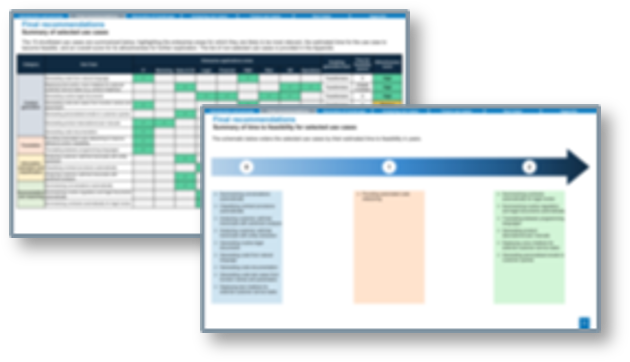Identified high-impact generative AI use cases and built a roadmap for enterprise deployment
CamIn works with early adopters to identify new opportunities enabled by emerging technology.
of CamIn’s project team comprised of leading industry and technology experts





Our telecoms client wanted to identify realistic use cases of generative AI for enterprise applications with clear business cases. CamIn identified 6 highly attractive generative AI deployments for the client to explore immediately.


The market for generative AI in enterprise applications is projected to exceed $100 billion by 2030. CamIn’s client had decided to integrate generative AI into its enterprise functions but needed confirmation of the exact use cases that would deliver meaningful business impacts across IT, legal, marketing, and R&D. With AI and generative AI being both complex and unfamiliar, and the use case landscape rapidly expanding, the client required expert guidance to identify the most feasible and high-value opportunities. CamIn was engaged to develop a clear strategic roadmap for integrating workable generative AI solutions into our client’s existing infrastructure.
.jpeg)
6 | Mapped 6 generative AI models, including: Transformers, diffusion models, variational autoencoders, and generative adversarial models |
100 | Identified 100 feasible use cases for generative AI across the client’s key enterprise application areas. |
15 | Assessed 15 high-priority use cases in terms of their technical feasibility as well as the scale of the potential benefits that they could unlock. |
6 | Identified the 6 most attractive use cases for the client, and providing insights as to how to ensure efficient, rapid deployments. |

CamIn identified the 6 most attractive use cases for the client, and provided insights as to how to ensure efficient, rapid deployment.

The client is now undertaking pilot studies to understand their effectiveness in detail prior to rolling out the systems across the company.

CamIn derisked and accelerated client’s expansion into generative AI for enterprise applications.
Download our detailed case study and discover how offshore automation improved efficiency, safety, and uptime for our client.





.svg)
Generative AI refers to a class of artificial intelligence technologies that can create new content, such as text, images, audio, code, and more, based on training data. Unlike traditional AI, which focuses on classification or prediction, gen AI models such as transformers, diffusion models, and generative adversarial networks (GANs) can generate human-like outputs and automate complex creative or cognitive tasks. In enterprise settings, this means accelerating document generation, content creation, and customer interactions at scale.
Telecoms companies operate in a complex, high-volume environment where efficiency, compliance, and customer engagement are critical. Generative AI provides powerful tools to automate content generation, streamline operations, and personalise services at scale. As demand for digital transformation accelerates, generative AI is becoming essential for telcos looking to boost productivity, reduce costs, and stay competitive.
Over the next decade, generative AI will become a core enabler of transformation in telecoms, redefining how firms operate, communicate, and innovate. As models become more capable and seamlessly integrated across business functions, telcos will shift from static workflows to adaptive, AI-augmented systems that improve speed, accuracy, and scalability.
Generative AI is powered by a fast-evolving ecosystem of model architectures and toolchains that are becoming increasingly viable for enterprise use:
Transformer-based large language models (LLMs): LLMs use transformer architectures to process and generate human-like text. Trained on massive corpora of text data, they excel at tasks like summarisation, translation, question answering, and content generation. Their self-attention mechanism allows them to understand context across long text passages, making them ideal for enterprise applications such as drafting reports, legal documents, or customer communications.
Diffusion models: Diffusion models generate high-resolution images and videos by learning to reverse a process that gradually adds noise to data. They excel at producing detailed, realistic media outputs and are increasingly used for synthetic visual content in marketing, training, and design workflows. These models provide high controllability and image fidelity, making them suitable for creative and visual applications.
Generative adversarial networks (GANs): GANs consist of two neural networks (a generator and a discriminator) that compete during training. The generator produces new data while the discriminator evaluates its realism. This adversarial setup enables GANs to generate highly realistic synthetic media, such as human faces or product mockups. They are especially useful in telecoms for avatar creation, synthetic datasets, and media content augmentation.
Variational autoencoders (VAEs): VAEs are probabilistic models that learn to encode data into compact latent representations and decode it back into original or new data samples. They are useful for structured generation tasks, anomaly detection, and synthetic data generation. VAEs allow for fine control over the generative process and are often used when interpretability and compression are key.
Autoregressive convolutional models: These models generate sequences, such as text, speech, or time-series data, one element at a time, using convolutional layers to speed up the process. They are optimised for real-time applications where low latency is critical, such as streaming services, chat interfaces, and responsive audio/voice tools.
Multimodal architectures: Multimodal models can handle and generate content across multiple data types (e.g. text, images, audio, video, code). They integrate different input/output formats within a single model, enabling unified AI interfaces. For telecoms, they are ideal for customer support systems that combine voice, document, and visual understanding into a cohesive service experience.